
Recently on Cyclingnews.com |
Tech feature, February 3, 2009
The right fit: Shaping Saxo Bank
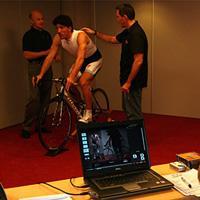
|
Comfort, efficiency and performance all matter when it comes to joining rider to bike. The Specialized BG FIT system is being used by the entire Saxo Bank team this season, and represents a significant undertaking by the ProTour squad. Cyclingnews' Shane Stokes watched several key riders undergo the sessions at the team training camp in Portugal.
Percentages win bike races. Although they were each three weeks long, last year's Grand Tours were all won by margins of between 46 seconds and 1'57" - a fraction of the overall time.
The 2007 Tour de France was even closer, with the podium riders being separated by just 31 seconds. In a race that was 91 hours long, Alberto Contador was just 0.007 percent quicker than Cadel Evans (Predictor Lotto), and 0.0095 percent faster than his Astana team-mate Levi Leipheimer. The same tiny margins apply with Classics and other one day races, where centimetres can mean everything after many hours in the saddle.
For that precise reason, there is a real emphasis on finding anything that can make the difference. Lighter bikes. Stiffer frames. Faster wheels. More-aerodynamic clothing. Yet the most logical of areas, the mating of man and machine, is often under-emphasised.
Wind tunnel testing has found favour in recent years, yet is just part of the picture. It's mainly used for time trials and the emphasis is on aerodynamics, even if there is a price to pay in terms of efficiency and comfort. It's not always the case that riders can stick to the recommended setup.
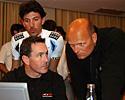
|
The Specialized BG FIT (Body Geometry Fit Integration Technology) process is part of what its exponents would say is a more holistic approach. Led by Dr Andy Pruitt of the Boulder Centre for Sports Medicine, the methods comprise a biomechanical assessment, on-bike analysis and modification of equipment and position to arrive at what they feel is the best possible balance. It utilises video cameras, computer software, limb-mounted sensors plus the expertise of people like Pruitt, a sports physician for 35 years, 'Senior Fit Professior' Scott Holz, and others. They in turn have trained Specialized dealers to carry out the same tasks, leading to a network of BGFIT assessors across the cycling world.
As a rider, Team Saxo Bank owner Bjarne Riis was known as someone who was fastidious about his equipment. He is curious about what BG FITS might do for his team, and to see if it lives up to its claims of a power and efficiency benefit.
"We cannot tell exactly right now, but I believe it will be of benefit," he said. "They are just small adjustments [being made] but small adjustments can also mean something. There are a few things that we look at that we have never seen before, never taken care of before, and I think it is interesting."
Cyclingnews watched several key riders being assessed, and documented the individual biomechanical variations plus the positional recommendations made to two Tour de France contenders and the world's top time trialist.
Fabian Cancellara - a study in strength and flexibility
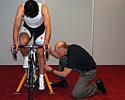
|
Olympic time trial champion Fabian Cancellara made a clear impression on Pruitt, with the American proclaiming after the medical assessment and initial bike fit that, "I have learned a lot about the reason for this guy's success in the last few minutes". The reason for his praise? Cancellara's considerable flexibility and strength, which enable him to comfortably hold an aerodynamic tuck during time trials. Of the Saxo Bank riders seen, Cancellara seemed to impress Pruitt most, biomechanically; in fact, he had some good news for the Swiss TT specialist after the examination.
As is always the case, the BG assessment started off with an examination of the rider off the bike. Cancellara was judged to have good shoulder strength, and was then asked to touch his toes; he did more than that, putting the palms of his hands flat on the ground and earning praise from the assessor. His leg length was found to be equal.
He was then asked to lie on his back, straighten his leg and raise it upwards towards the vertical; he was found to have 85 degrees of angle on the right leg, with three more on the left. Pruitt was clearly impressed with this, saying that it was "very flexible for a big guy", while bringing his knees to his chest revealed what was termed, "huge glute [gluteal] flexibility," namely a right leg reading of 130 degrees and a left leg of 135. His glute strength was judged by Pruitt to be 'bulletproof'.
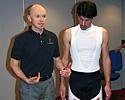
|
Like the other riders on the Saxo Bank team, Cancellara will this year be using Specialized's Body Geometry shoes. His size 44.5 footwear had the standard 1.5 mm Varus Wedge slope built in, angling the feet slightly from the horizontal plane.
One on his road bike, Pruitt checked his symmetry and existing position. Cancellara was seen to have a tendency to sit with his right hip slightly forward, and to roll his right knee inwards under pressure; an additional 1.5mm shim was suggested for the shoe on that side and that, plus a recommended change to the more supportive blue Specialized insoles, led to a straighter tracking of his knee.
The aforementioned boost for Cancellara was the news that due to his flexibility and strength, his time trial position can actually be set lower than it currently is. Pruitt favours three settings for time trials; the lowest, most aerodynamic is for prologues, the intermediate is for time trials up to an hour long, and the highest is for anything longer than that. Cancellara's current position actually fits into this third category, and so he can go lower (and become more aero) with no loss in power. The expected increase in speed is good news for him, and bad for his time trial rivals.
Overall, Pruitt was very impressed. "You are truly made to be a time trialist," he told the Olympic champion.
Frank Schleck - making the most of strengths
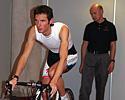
|
In contrast to his team-mate, Frank Schleck had poor flexibility in places and this required bike changes in the opposite direction. Unable to touch his toes when standing, his straight leg raise while lying down saw him achieve a 75% angle, compared to 85 and 88 degrees for Cancellara. "That's not good for the time trial bike," said Pruitt, referring to the restriction this would place on his hip and trunk when he was at the bottom of the pedal stroke.
However this was contrasted with a better degree of flexibility when his knee was brought to his chest. The numbers here were 130 and 128 degrees for right and left legs, a little closer to his team-mate's reading.
The short hamstrings are something that will affect how flat Schleck's back can be in a time trial. "Once in a while I do some stretching," he said when asked, the tone of voice suggesting that it was the exception rather than the rule. He has been asked to do more of this in future.
Schleck senior also has what Pruitt termed 'very flexible feet', the doctor telling him that this stops him having a good foundation to push on the pedals. "That's why, for you, shoe choice is crucial," he said. That importance was further underlined when Pruitt asked him to stand on one leg in socks and lower himself towards the floor; as his supporting knee bent, it swung inwards, showing how his flat, flexible feet prevented knee stability. Both Schleck brothers also have a natural mild internal femoral rotation, further increasing the importance to have the correct setup of shoes and pedals.
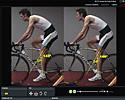
|
Schleck told Pruitt that he experiences a sore neck while riding. Once on the bike Pruitt tackled the reason for this, raising his bars slightly and also fitting a stem which was 10 mm shorter than before. Schleck had previously tended to grasp the bars behind the hoods, but appeared much more comfortable after the change was made. The expectation was that his shoulders would feel less of a strain in future.
Schleck's knee stability was addressed by the recommenced use of blue Specialized BG insoles in his shoes, plus the use of a 1.5mm Varus Wedge. He was filmed while riding under load and, via analysis of the angle difference between his upper and lower legs when at the bottom of the pedal stroke, it was determined that his saddle was too low. However, his short hamstrings ensured that the raising of his saddle was compensated for by an equal raising of his heel; he pointed his toe more, maintaining that slightly inefficient leg angle.
Pruitt's recommendation saw his saddle raised by three millimetres, with more elevation of that possible when Schleck carries out the recommended stretches. "At the moment, we can raise it all we like and he'll keep just pointing his toe more to overcome that change," he said.
His time trial position was also changed, with the saddle height increasing slightly and his handlebars going up by a greater amount. The latter would have a small effect in increasing drag but, according to the BG crew, it should be more than compensated for via an increase in power. That's good news for Schleck, who traditionally has lost time to his rivals in races against the clock.
Read Part II for fitting with Andy Schleck and the other Saxo Bank riders as well as photos and some information on the difference between bike fitting and wind tunnel testing.

